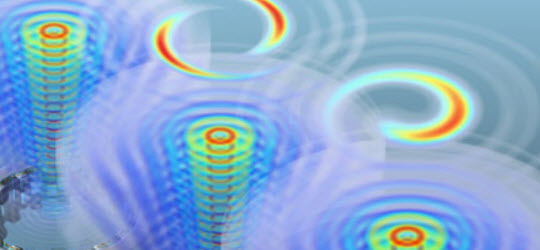Quantum cryptography for mobile phones
April 4, 2014

Integrated orbital angular momentum devices array (credit: University of Bristol Centre for Quantum Photonics)
An ultra-high-security scheme that could one day get quantum cryptography using Quantum Key Distribution into mobile devices has been developed and demonstrated by researchers from the University of Bristol’s Center for Quantum Photonics (CQP) in collaboration with Nokia.
Currently available quantum cryptography technology is bulky, expensive, and limited to fixed physical locations — often server rooms in a bank. The team at Bristol has shown how it is possible to reduce these bulky and expensive resources to an optical chip in a mobile handset.
The scheme relies on the breakthrough protocol developed by CQP research fellow Anthony Laing and colleagues, which allows robust exchange of quantum information through an unstable environment. The research is published in Physical Review Letters.
Deploying in a real communications network
“The next step is to take our scheme out of the lab and deploy it in a real communications network,” said Laing, and could shortly lead to the production of the first “NSA-proof” mobile phone. The system uses photons as the information carrier and the scheme relies on integrated quantum circuits developed at the University of Bristol.
The Center for Quantum Photonics, a pioneering research group in quantum technologies, has more than 70 members and a grant portfolio of more than £20million. It has made a quantum computer called “Quantum in the Cloud” — featuring a web interface to a small-scale quantum processor — publicly accessible and available online for the purposes of educating those interested in future quantum computing technologies.
This work was supported by EPSRC, ERC, QUANTIP, PHORBITEC, and NSQI, with support from the Fundamental Research Funds for the Central Universities and the National Natural Science Foundation of China, and a Royal Society Wolfson Merit Award and a Royal Academy of Engineering Chair in Emerging Technologies.
Professor Jeremy O’Brien — EPSRC Global Engineering Challenges
Abstract of Physical Review Letters paper
We demonstrate a client-server quantum key distribution (QKD) scheme. Large resources such as laser and detectors are situated at the server side, which is accessible via telecom fiber to a client requiring only an on-chip polarization rotator, which may be integrated into a handheld device. The detrimental effects of unstable fiber birefringence are overcome by employing the reference-frame-independent QKD protocol for polarization qubits in polarization maintaining fiber, where standard QKD protocols fail, as we show for comparison. This opens the way for quantum enhanced secure communications between companies and members of the general public equipped with handheld mobile devices, via telecom-fiber tethering.
